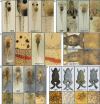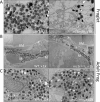Disruption of mc1r Disturbs Skin Pigmentation in Xenopus tropicalis
- PMID: 40524449
- PMCID: PMC12171348
- DOI: 10.1111/pcmr.70033
Disruption of mc1r Disturbs Skin Pigmentation in Xenopus tropicalis
Abstract
The melanocortin 1 receptor (MC1R) is well-established as a pivotal regulator of pigmentation in various species. Despite a wealth of research focused on mammals and fish, the role of Mc1r in amphibians has remained largely unexplored. This study was designed to elucidate the contribution of Mc1r in Xenopus tropicalis. Our results reveal that targeted ablation of mc1r in Xenopus tropicalis led to a significant reduction in dorsal skin pigmentation, while simultaneously accelerating the onset of melanophore pigmentation in the ventral region. This dual effect resulted in a perturbation of the canonical countershading pattern. Additionally, knockout of mc1r disrupted the expression of multiple genes primarily associated with pigmentation. Collectively, these findings underscore the critical role of MC1R in the regulation of pigmentation and the development of countershading in amphibians, contributing to the growing body of literature on the evolution and function of MC1R across vertebrate species.
Keywords: Xenopus tropicalis; Mc1r; CRISPR‐Cas9; countershading; pigmentation.
© 2025 The Author(s). Pigment Cell & Melanoma Research published by John Wiley & Sons Ltd.
Conflict of interest statement
The authors declare no conflicts of interest.
Figures









Similar articles
-
Loss-of-function mutations in the melanocortin 1 receptor cause disruption of dorso-ventral countershading in teleost fish.Pigment Cell Melanoma Res. 2019 Nov;32(6):817-828. doi: 10.1111/pcmr.12806. Epub 2019 Jul 12. Pigment Cell Melanoma Res. 2019. PMID: 31251842
-
A Ball Python Colour Morph Implicates MC1R in Melanophore-Xanthophore Distribution and Pattern Formation.Pigment Cell Melanoma Res. 2025 Jan;38(1):e13215. doi: 10.1111/pcmr.13215. Epub 2024 Nov 28. Pigment Cell Melanoma Res. 2025. PMID: 39609249
-
Left-right pigmentation pattern of Japanese flounder corresponds to expression levels of melanocortin receptors (MC1R and MC5R), but not to agouti signaling protein 1 (ASIP1) expression.Gen Comp Endocrinol. 2018 Jun 1;262:90-98. doi: 10.1016/j.ygcen.2018.03.019. Epub 2018 Mar 21. Gen Comp Endocrinol. 2018. PMID: 29574149
-
Fish pigmentation and the melanocortin system.Comp Biochem Physiol A Mol Integr Physiol. 2017 Sep;211:26-33. doi: 10.1016/j.cbpa.2017.06.001. Epub 2017 Jun 7. Comp Biochem Physiol A Mol Integr Physiol. 2017. PMID: 28599948 Review.
-
A meta-analysis of genome-wide association studies to identify candidate genes associated with feed efficiency traits in pigs.J Anim Sci. 2025 Jan 4;103:skaf010. doi: 10.1093/jas/skaf010. J Anim Sci. 2025. PMID: 39847436 Free PMC article.
References
MeSH terms
Substances
Grants and funding
LinkOut - more resources
Full Text Sources

